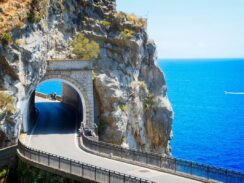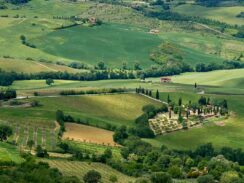The Amalfi Coast – an itinerary

The Amalfi Coast, or costiera amalfitana, is one of our favorite places in Italy. The dramatic mountain cliffs rise up against the emerald-blue sea sparkling in the sunlight below. Pastel-colored villages carved into the mountainside shine vibrantly against the landscape, while scented lemon groves and a salty sea breeze fill the air.
The Amalfi Coast is the 60 km (37 mile) stretch of coastline between Sorrento and Salerno, located just south of the Bay of Naples. The most charismatic part of the coast is between the cities of Positano and Vietri sul Mare. 36 km (22 miles) separate the two cities. When we visit, we arrive by car from Rome, exiting the A1 Autostrada at Vietri sul Mare, on the southern part of that stretch, and we work our way up to Positano. See our blog post with driving directions and tips for driving on the Amalfi Coast if you plan to rent a car.
The itinerary below is our favorite. It can be done in a day if you are on a quick timeline, or you can slow things down and stay a few nights. We recommend the latter – the Amalfi Coast is best enjoyed when you are not rushed.
Vietri sul Mare
Vietri sul Mare is famous for its hand-painted ceramics. Ceramic-tiled storefronts line the main street of the village. Inside there are dishes, vases, urns, wall tiles and countless other items hand painted in vibrant colors in the traditional style of the Amalfi Coast. Stefano and I began a collection of dishes years and years ago, and each time we go back, we acquire a few more pieces. It’s a two-and-a-half to three-hour drive from Rome to Vietri sul Mare. Plan to arrive in the morning and do your shopping before lunch, as shops will close for the pausa pomeridiana, or afternoon break, at 1:00.

Ravello
Leave Vietri sul Mare and proceed west along the coastal road. When you arrive at the village of Castiglione, turn right and follow Via Castiglione up the mountain to the city of Ravello.
Ravello sits high on the mountain overlooking the Amalfi Coast below. The quaint town has been home to many famous artists, musicians, and writers, including Richard Wagner, who found inspiration for his opera Parsifal while staying in the city, and D.H. Lawrence, who wrote Lady Chatterley’s Lover here.
Ravello is home to two villas with striking architecture and gorgeous gardens. Villa Rufolo, originally a watchtower, is an oasis of serenity with its Moorish cloister that reflects the Arab cultural influence and its immaculately cured garden on a terrace overlooking the Mediterranean. Wagner loved this garden, and each summer during the Ravello Festival, concerts are held here, the sea serving as a spectacular backdrop to the orchestra stage. Villa Cimbrone is equally beautiful, with its lush gardens, temples, statues, and fountains and its famous terrace named Belvedere of Infinity for its view out over the coast and the vast expanse of sea below.
Spend the night in Ravello. There are many hotel choices at a variety of price points. Some hotels are located just outside the gates of the city, just off of the main road, and are quite accessible. Others are tucked away inside the town, often down narrow cobblestone paths. Before making a reservation, ask about parking (there essentially is none inside the city walls) and also about luggage services. Be specific about where the nearest parking is, what parking costs, how far there is to walk, whether it is up or down hills, and if there is help with luggage. And of course, request a room with a sea view. We stayed Villa San Michele years ago and loved it.

Amalfi
Once the capital of the powerful Maritime Republic of Amalfi but later ravaged by years of natural disaster and poverty, Amalfi is now a quaint, if touristy, town. As you approach the city by car, you will see several municipal parking lots near the shore, often with city traffic officers directing tourists into parking spaces. Be prepared to pay the high parking fees – there is simply no alternative.
Head up the hill into Piazza Duomo, the town square. Admire the cherubs and chuckle at the nymph’s water-jetting bosom at the Fontana di Sant’Andrea in the center of the square, and then turn to your right and visit Pasticceria Pansa for a Neopolitan-style pastry and a cappuccino or a cup of tea. Make a mental note to return to buy some chocolate-dipped candied citrus peel or babà al limoncello to take home with you.
Adjacent to Pasticceria Pansa is the impressive 10th-century Duomo di Sant’Andrea with its Arab, Norman, and Gothic influences. Climb the 62 steps to the cathedral and admire its bronze doors, which were cast in Constantinople in AD 1044. Inside the Duomo, frescos cover the walls of the Baroque interior. Be sure not to miss the Cloister of Paradise on the left side of the cathedral’s portico, with its Moorish white marble arches and beautiful garden.
After exiting the Duomo, walk up Amalfi’s streets and into the village’s small alleyways. Although the small shops are often over-priced, some fun items can be found. Look for confections of limoncello, the lemon-infused liquor made popular by the Amalfi Coast, or glass jars of tuna canned in olive oil. We promise you it will be the best tuna you’ve tasted. Before returning to your car, stroll down the shoreline to see the quaint fishing boats and the occasional yacht docked in the harbor.

Positano
Positano is a jet-set and touristy village built steeply and dramatically into the side of the mountain in stunning pastel colors that glow in the evening sunlight.
Parking in Positano is challenging. If you plan to spend the night, be sure to find a hotel that offers parking. In the best case scenario, you will pull off on the side of the road in front of your hotel, go in to check in, and hand your keys over to a valet, and not worry about your car again until you are ready to leave Positano. Luggage service is another thing to ask about. Steep staircases have been cut into the mountain to allow locals and tourists to move about through the village, but you don’t want to try to go up and down those with heavy suitcases! If your accommodation does not include parking, be prepared to pay high rates to park in a private garage.
In Positano, stroll up and down the charismatic labyrinth of streets. Shopping is one of the highlights of this little town and hand-crafted, made-to-measure strappy leather sandals are what Positano is famous for. You can choose from a variety of styles and leathers, and in about 10 minutes, you will have your sandals made exclusively for you. They will cost a pretty penny, but will also last forever.
Wander down to the beach to soak up some Mediterranean sun. There are two beaches: Spiaggia di Marina Grande is the busiest, while Spiaggia di Formillo, a little further west, is quieter. Don’t expect white sand; both beaches are made up of small, round pebbles. You will want sandals to walk in, and if you plan on spending time on the beach, it is worth renting chairs and an umbrella. From the beach, you can see Li Galli, the archipelago of little islands just off of the coast that are said to be where the Sirens seduced Ulysses and other ship captains in Homer’s Odyssey. The coast is home to dozens of spots to grab a drink, an afternoon aperitif, or dinner.
If you prefer action over relaxation, consider taking a ferry to the islands of Ischia, Procida, or Capri for a day trip. You will see a lot of advertising for the Grotta dello Smeraldo, an emerald-glowing sea cave full of stalactites and stalagmites. Pass on that – it’s over-rated – and take an evening boat trip, instead.


